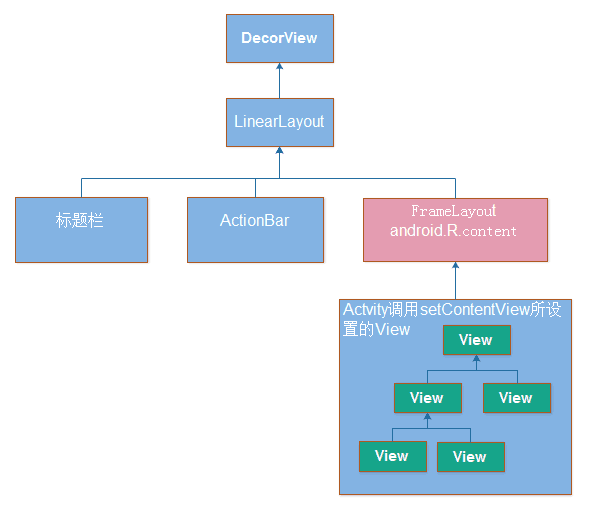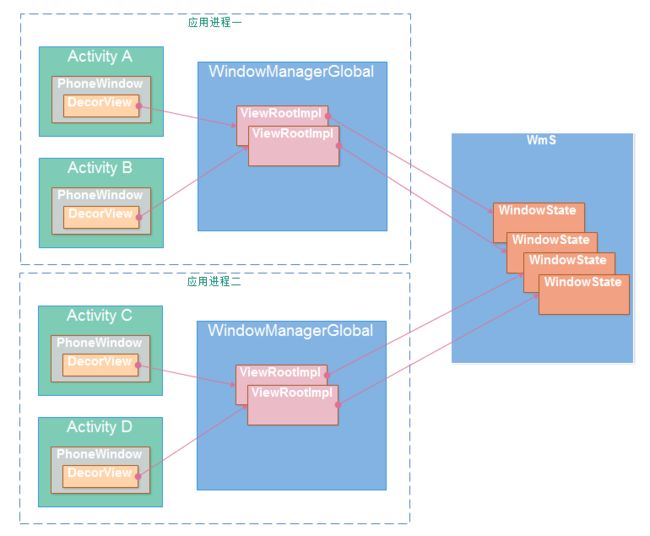Activity像一个工匠(控制单元),Window像窗户(承载模型),View像窗花(显示视图)
LayoutInflater像剪刀,Xml配置像窗花图纸。
Window
是一个抽象类, 实现由PhoneWindow完成
DecorView
在4.4.4-6.0版本 DecorView 是 PhoneWindow 的子类.本着最小惊异原则
从7.0开始, DecorView 从PhoneWindow中抽出来, 并且为了 DecorCaptionView 的关联加入了一系列方法
DecorView 继承自 FrameLayout,
包含了 statusBar 和 NavigationBar
以及一个LinearLayout,
这个LinearLayout,包含了TitleBar的实现类ActionBar/ToolBar + contentView
DecorView对比
5.0比4.4多了
mStatusColorView
mNavigationColorView
7.0版本 DecorView 不再是 PhoneWindow 的子类, 因为多了DecorCaptionView()
DecorView组成
- Activity & Window & WMS
Window: 定义窗口样式和行为的抽象基类,用于作为顶层的view加到WindowManager中,其实现类是PhoneWindow。
每个Window都需要指定一个Type(应用窗口、子窗口、系统窗口)。Activity对应的窗口是应用窗口;PopupWindow,ContextMenu,OptionMenu是常用的子窗口;像Toast和系统警告提示框(如ANR)就是系窗口,还有很多应用的悬浮框也属于系统窗口类型。
WindowManager:用来在应用与window之间的管理接口,管理窗口顺序,消息等。
WindowManagerService:简称Wms,WindowManagerService管理窗口的创建、更新和删除,显示顺序等,是WindowManager这个管理接口的真正的实现类。它运行在System_server进程,作为服务端,客户端(应用程序)通过IPC调用和它进行交互。
Token:这里提到的Token主是指窗口令牌(Window Token),是一种特殊的Binder令牌,Wms用它唯一标识系统中的一个窗口。
Activity有一个PhoneWindow,当我们调用setContentView时,其实最终结果是把我们的DecorView作为子View添加到PhoneWindow的DecorView中。而最终这个DecorView,通过WindowMnagerImpl的addView方法添加到WMS中去的,由WMS负责管理和绘制(真正的绘制在SurfaceFlinger服务中)。
setContentView流程(7.1.1)
Activity 中
Activity.setContentView() 调用了Window.setContentView(), 最后在Window的子类PhoneWindow中实现.-
PhoneWindow.setContentView
先判断 mContentParent 是否为空, 第一次加载时肯定为空, 那么跳到 installDocker, 主要干了两件大事,- DecorView mDecor = generateDecor(), 构造 DecorView 并传入 context
第一次创建的话直接 getContext() 拿到上下文,否则通过 DecorContext 的构造方法创建context - ViewGroup mContentParent = generateLayout(mDecor); 创建ViewGroup加载资源
- 最后 通过 mDecor.onResourcesLoaded(mLayoutInflater, layoutResource); mContentParent 打入 mDecor
- 调用 onContentChanged 提示布局完成
- DecorView mDecor = generateDecor(), 构造 DecorView 并传入 context
ActivityThread 的 handleResumeActivity
先通过 performResumeActivity 调用 activity 的 performResume 去唤起 mInstrumentation.callActivityOnResume(this);
然后DecorView 设置 LayoutParam
最后调用 Activity 的 makeVisible 把 DecorView attach到 Window, 在 view 被 attach 到 window 的时候会调用 onAttachedToWindow()此时可修改 Activity 窗口大小
window 的构造方法里就需要设置 mFeatures, 所以在 PhoneWindow 被创建之前 也就是 setContentView 被调用之前就需要先设置好 mFeatures, 所以 requestWindowFeature 需要在 Window.onContentView 之前设置
WindowManagerService 继承自 IWindowManager.Stub, 这个文件在 FrameWork 源码里找不到, 是 AIDL 在编译时自动生成的
Dialog 为什么不能用别的 contextFrom
-
Dialog 是 TYPE_APPLICATION 型的窗口
Dialog 的 show 方法中public void show() { // 忽略一些代码 mDecor = mWindow.getDecorView(); WindowManager.LayoutParams l = mWindow.getAttributes(); if ((l.softInputMode & WindowManager.LayoutParams.SOFT_INPUT_IS_FORWARD_NAVIGATION) == 0) { WindowManager.LayoutParams nl = new WindowManager.LayoutParams(); nl.copyFrom(l); nl.softInputMode |= WindowManager.LayoutParams.SOFT_INPUT_IS_FORWARD_NAVIGATION; l = nl; } try { mWindowManager.addView(mDecor, l); mShowing = true; sendShowMessage(); } finally { } }其中
WindowManager.LayoutParams l = mWindow.getAttributes();调用了window的
getAttributes方法, 返回的是new WindowManager.LayoutParams();,
最后在 WindowManager 中拿的是public LayoutParams() { super(LayoutParams.MATCH_PARENT, LayoutParams.MATCH_PARENT); type = TYPE_APPLICATION; format = PixelFormat.OPAQUE; }所以 Dialog 是 TYPE_APPLICATION 类型.
系统对于 TYPE_APPLICATION 类型的窗口, 要求必须是 Activity 的 token. ViewRootImpl.setView方法 调用 mWindowSession.addToDisplay, 通过 IWindowSession 发送添加View的请求后, 返回一个值, 根据数值判断, 报 BadTokenException 异常.(C++层面)
-
Dialog 在构造时传入的 context
Dialog(@NonNull Context context, @StyleRes int themeResId, boolean createContextThemeWrapper) { // 忽略一些代码 mWindowManager = (WindowManager) context.getSystemService(Context.WINDOW_SERVICE); final Window w = new PhoneWindow(mContext); mWindow = w; w.setCallback(this); w.setOnWindowDismissedCallback(this); w.setWindowManager(mWindowManager, null, null); w.setGravity(Gravity.CENTER); mListenersHandler = new ListenersHandler(this); }Dialog 在构造时传入的context, 默认是通过 Context.getSystemService 来获取 WindowManager, 如果用Application 或者 Service 的 context 会直接获取 WindowManagerImpl 的实例,这个实例里 token 为 null, 那么在 show 时传过去的也是 null
而如果是Activity, 在handleLaunchActivity 里调用 performLaunchActivity()里调用 activity.attach()时, 传入了token, Activity 又自己重写了 getSystemService 方法,
@Override public Object getSystemService(@ServiceName @NonNull String name) { if (getBaseContext() == null) { throw new IllegalStateException( "System services not available to Activities before onCreate()"); } if (WINDOW_SERVICE.equals(name)) { return mWindowManager; } else if (SEARCH_SERVICE.equals(name)) { ensureSearchManager(); return mSearchManager; } return super.getSystemService(name); }所以在 dialog 构造方法中的 getSystemService 拿到的是 Activity 的 mWindowManager
mWindowManager = (WindowManager) context.getSystemService(Context.WINDOW_SERVICE);
可以尝试弹出一个特殊的系统级弹窗来曲线救国
manifest 中添加
dialog.show() 之前添加
alertDialog.getWindow().setType(WindowManager.LayoutParams.TYPE_SYSTEM_ERROR);
有些手机需要打开悬浮窗权限
参考
| 为什么Dialog不能用Application的Context
CSDN | setContentView源码分析

